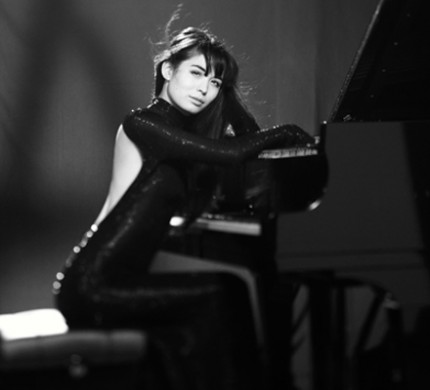Pianist Ott shows dazzle and depth in Chicago recital debut

Alice Sara Ott made her Chicago recital debut Sunday afternoon at Symphony Center.
Twenty-four-year-old Alice Sara Ott is not yet a familiar name even among keyboard aficionados, at least in the United States, but that is likely to change quickly, judging by the enthralling performance she delivered Sunday afternoon under the auspices of Symphony Center Presents.
The concert was her Chicago recital debut, and it will be followed Tuesday with her New York recital debut at Le Poisson Rouge – two big career milestones as this Munich-based German-Japanese pianist works to heighten her profile in this country.
Ott possesses dazzling technique and abundant power, but with her, it is never technical bravura for its own sake. Indeed, what was so impressive Sunday was how she was able to channel her obvious talents with such self-assuredness, maturity and élan, drawing an impressively nuanced tonal range from the piano and achieving a pleasing musicality throughout the afternoon.
All these qualities were on view in the evening’s second-half centerpiece, Franz Liszt’s Grandes études de Paganini, which, as the title suggests, consist of devilishly challenging keyboard arrangements of some of celebrated violinist Nicolò Paganini’s Caprices for unaccompanied violin. Ott regularly performs Liszt’s music and is obviously at home in it. Playing barefoot (as is her custom), she dove into this set of six études with gusto, reveling in the showmanship and pyrotechnics they demand while never losing sight of the Etudes as expressive musical works.
Highlights included Etude No. 2, in which she flicked and flitted across the keyboard with a suitably light, buoyant touch, and Etude No. 3, with its pianistic evocations of violin glissandos, double stops, left-hand pizzicatos and no shortage of finger-twisting effects. She handled it with virtuosic flair, matching an almost Debussy-like delicacy in certain parts with the explosive oomph demanded elsewhere, bringing it all to a suitably bravura finish.
But as impressive as the Liszt display was, the evening’s most memorable selection came on the first half withmFranz Schubert’s Piano Sonata in D major, D. 850.
Things did not start out so well. Allowing youthful exuberance to get the best of her, Ott seemed to be pressing at the beginning of the first movement before finally settling in for a satisfying romp. She hit her stride in the slow second movement, drawing a handsome, rounded tone from the piano and delivering a leisurely, spacious interpretation with just the right measured tempo and dynamics.
Her wonderfully spirited take on the Scherzo third movement snappily conveyed its strong rhythmic sense and dance-like feel. She rounded everything out with a suitably sprightly take on the Rondo fourth movement. In all, it was a captivating performance made all the better by how much she seemed to enjoy performing it.
The program’s short opening work, Mozart’s Nine Variations in D major on a Minuet by J.P. Duport, K. 573, was a pleasant enough “amuse-oreille,” but in light of everything that followed, it was all but forgotten by evening’s end. Ott’s playing here was fine, but there was little she was able do to offset the inevitably lightweight nature of this piece.
As an encore, she presented Beethoven’s well-known Bagatelle in A minor, Für Elise. As history has shown, big predictions about promising young soloists can all too easily go unrealized, but it seems safe to say that the classical world can count on bigger things yet from this young keyboard dynamo.